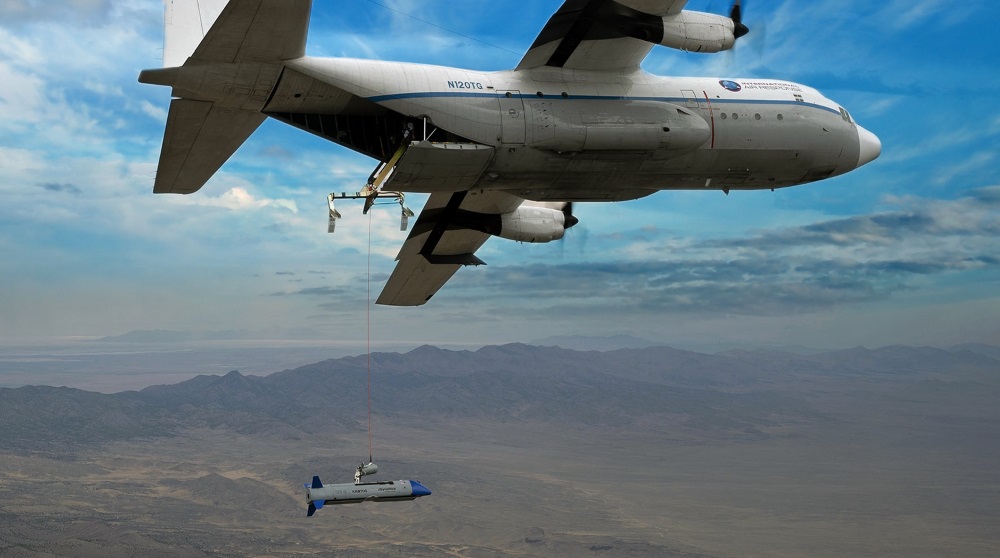, a wholly owned subsidiary of Leidos, successfully tested a second X-61A Gremlins Air Vehicle (GAV), as well as the Gremlins airborne recovery system, last month at Dugway Proving Ground in Utah for the Defense Advanced Research Projects Agency (DARPA).
The series of tests focused on risk reduction, as well as system and subsystem performance verification, in preparation for an airborne recovery test later this year. The overarching goal of the Gremlins Program, managed by DARPA’s Tactical Technology Office, is to demonstrate aerial launch and recovery of multiple low-cost reusable unmanned aerial systems (UASs).
The test series involved all segments of the Gremlins Demonstration System, including GAVs, the launch and recovery system, the airborne operator control station and the Gremlins command, control and communications system. The test flight was originally scheduled for earlier this spring, but was delayed due to the global pandemic caused by COVID-19.
“We have taken a major step forward towards accomplishing airborne recovery, and we are ever so close to achieving it,” said Tim Keeter, program manager for the Dynetics Gremlins team. “Our second GAV flown to date performed very well, which increases our confidence in the X-61A. And for the first time, we rendezvoused and flew in close formation with the recovery C-130 multiple times using the Gremlins Autonomous Docking System (GADS). Multiple captive tests were also conducted for the first time, with actively-controlled GAVs attached to the stabilized towed docking device. This demonstrated the ability of the recovery system to safely reel in and stow GAVs once they have docked. The data collected from these tests will provide the necessary information to perform final tuning of GADS.”
The second X-61A flew for a total flight time of 2 hours and 12 minutes. It flew in formation with the C-130 from as close as 125 feet back and 125 feet below the C-130 position. At the end of the test, the GAV was recovered on the ground using the parachute system.
“Our team was excited to fly the GAV for a second time following the delays caused by the global pandemic,” said Brandon Hiller, Dynetics X-61A chief engineer. “While we successfully tested both the GAV and recovery system, we decided during the mission to stop short of docking. We now have additional data, which will help us tune the system and further validate our models. These results are encouraging and present higher confidence to achieve airborne recovery in our next flight.”
The roll-on/roll-off recovery system (which includes the physical structure, the docking structure, the towed, attitude-controlled “Bullet” and the in-flight stowage system) performed as designed. Marvin Hill, Dynetics X-61A recovery system chief engineer stated,
“As we expected, reeling the GAV in while docked on the Bullet, and then securing it inside the C-130 cargo bay is a safe and benign activity. It’s like fishing in the sky, except the fish weighs 1,200 pounds.”
“We’re excited to continue our progress with the Gremlins program,” said Keeter. “This is what we’ve been working towards for the past four years, and we are eager to advance the Gremlins system’s capabilities for DARPA and the warfighter even further. Rapid and reliable airborne recovery is a game-changing capability for autonomous, distributed airborne operations. Our entire team brought about a disciplined test demonstration and moved the program forward. We believe Gremlins will advance operational flexibility and effectiveness in the near future.”
The Dynetics Gremlins team consists of the following companies, each representing best-in-class capabilities for their roles on the program: Kratos Unmanned Aerial Systems, Williams International, Applied Systems Engineering, Inc., Kutta Technologies, Inc., Moog Inc., Sierra Nevada Corporation, Systima Technologies, Inc. and Airborne Systems. Additional support for the flight test included Dugway’s Rapid Integration and Acceptance Center (RIAC), International Air Response and High-G Technologies.
The Dynetics team was one of four companies awarded a Phase 1 contract for the Gremlins program in 2016. Phase 2 was awarded in March 2017 to two of the initial four performers, and Phase 3 followed in April 2018, when Dynetics was named the top performer. The maiden flight of the X-61A occurred in November 2019, flying as predicted with no anomalies in the operational system.
Source: Press Release

